Why Going Fully Electric is Harder Than You Think (And How to Do It Anyway)
So you’ve made the leap to an electric vehicle and now you’re ready to convert it into your dream campervan. You want to go completely electric – no fossil fuels, no gas bottles, just pure, clean electricity powering every aspect of your mobile home. Noble goal, right?
Here’s the thing: heating your electric campervan is possible. We do it all the time. But when it comes to creating heat – whether that’s for cooking your morning eggs or staying warm on a chilly Scottish evening – the physics gets interesting. And by interesting, we mean challenging.
Let’s dive into why heating an electric campervan off-grid is the biggest technical hurdle you’ll face, and what your realistic options actually are.
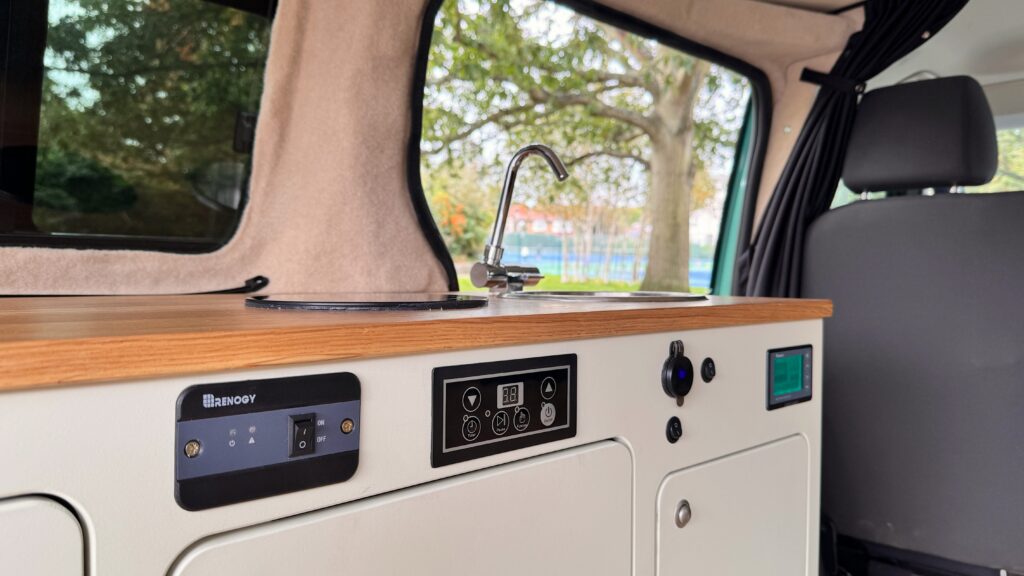
Understanding Your Campervan’s Electrical System (It’s Not What You Think)
First things first: your campervan’s electrical system is completely separate from your electric vehicle. Think of it like a boat, not a house on wheels.
While your EV runs on high-voltage batteries (typically 400V+), your campervan’s habitation system operates on 12 volts – the same as a marine vessel. This is crucial to understand because it explains why creating heat off-grid is so bloody difficult.
Your home runs on 230V AC power, which is nearly 20 times the voltage of your campervan system. This higher voltage makes powering heat-generating appliances relatively straightforward. In your campervan? Not so much.

Why Does This Matter?
Most appliances designed for campervans – your fridge, lights, water pump – are all built to run on 12V. They’re efficient, lightweight, and work beautifully with your leisure battery setup.
But here’s where heat becomes the villain in our story: 12V simply isn’t powerful enough to generate meaningful heat for any length of time.
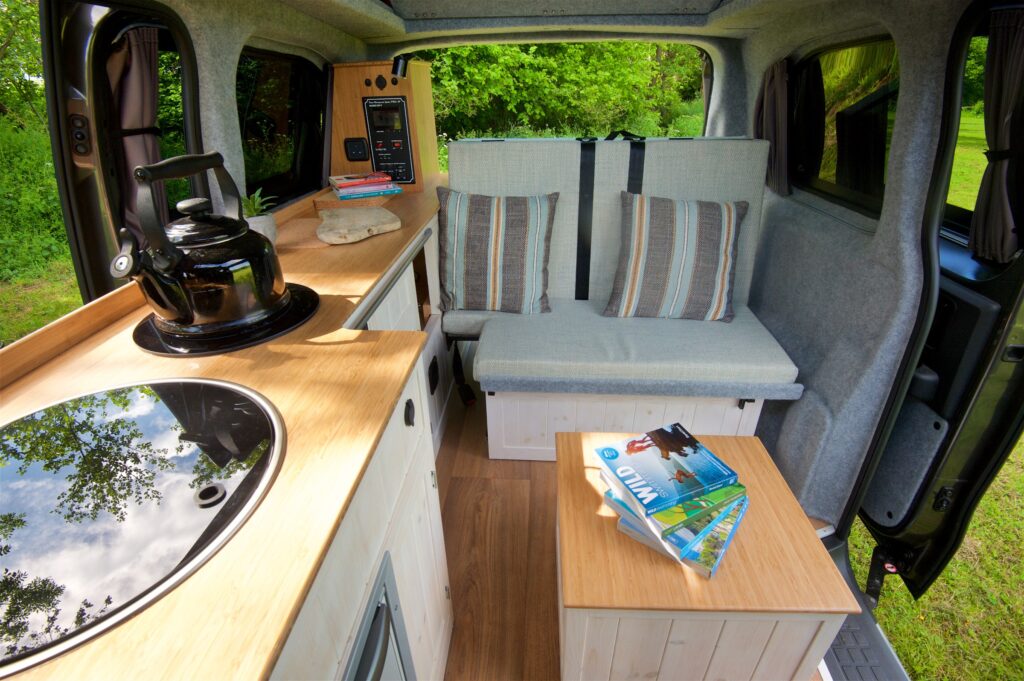
The Cooking Conundrum: Why There’s No Such Thing as a 12V Induction Hob
Let’s talk about cooking first, because it’s the easier of the two heat challenges (which tells you something about the heating challenge).
You might be thinking: “Surely someone makes a 12V induction hob?” They don’t. And there’s a good reason why.
Induction hobs work by using electromagnetic fields to generate heat directly within cookware, and unfortunately, there are no 12V induction cooktops currently on the market. The power requirements are simply too high for a native 12V system to handle.
So if you want to cook with electricity (rather than gas), you need a standard domestic 230V induction hob. And that means solving two problems:
Problem 1: You Need More Power
A typical campervan induction hob draws between 1500W and 2800W depending on whether it’s a single or double burner. That’s serious power – roughly equivalent to running 125 amps continuously from your 12V battery system.
To make this work, you need:
A Lithium Battery Bank: We’re talking a minimum of 300Ah (amp-hours) of lithium battery capacity. Lead-acid batteries simply won’t cut it – they’re too heavy, too inefficient, and can’t deliver the consistent high-current output you need. A quality lithium setup gives you the power density and discharge characteristics necessary for cooking off-grid.
Why not less? Well, you could install a smaller battery, but you’d only be able to cook for a few minutes before depleting it. Most people want to actually finish cooking their meal, so 300Ah is the realistic minimum. More is better.
Problem 2: You Need to Convert 12V to 230V
This is where an inverter comes in. Think of it as a voltage translator – it takes your 12V battery power and converts it into the 230V AC power your induction hob needs.
For induction cooking, you need a large pure sine wave inverter – we fit 2000W inverters, which provides the power needed to run induction hobs effectively. Why 2000W? Because when you turn on a high-power appliance, there’s an initial surge that can exceed the normal running wattage, and a 2000W inverter handles typical campervan induction hobs (which draw 1500-2800W) appropriately.
And just to be clear on terminology: we measure battery capacity in amp-hours (Ah), not watts. The inverter is measured in watts (W) of output power. They’re different things, and you need to size both correctly.
Problem 3: Keeping Everything Charged
Having a big battery and inverter is pointless if you can’t recharge them. This is where your system starts to get more complex (and more expensive):
Battery-to-Battery Charger: In an electric vehicle, this charges your 12V leisure battery from your vehicle’s auxiliary battery while you’re driving – similar to how fossil-fueled vehicles charge from the alternator. It’s essential, but on its own, it’s not enough for heavy cooking use.
Now, you might be wondering: “Why can’t we just draw more power from the vehicle’s main traction battery?” The short answer is: that would be extremely problematic. Your EV’s traction battery is a high-voltage system designed specifically for propulsion, and attempting to draw significant additional power for habitation systems would create serious safety concerns, potentially damage the vehicle’s battery management system, and almost certainly void your vehicle warranty. The leisure battery system must remain separate and independent.
Solar Panels: Off-grid cooking means you need solar charging. In a small van with flexible panels, you’re typically looking at around 140W of solar capacity. While this might sound modest, modern flexible panels are remarkably efficient, and 140W provides a solid foundation for your charging needs when combined with your battery-to-battery charger. The key is that every bit of solar generation reduces your reliance on driving or hook-up for recharging.
Shore Power Charging: When you are at a campsite with hook-up, you can charge directly from the mains, which takes the pressure off your other charging sources.
The bottom line? A fully electric campervan system with induction cooking costs significantly more than one with a gas hob. The components are more expensive, the installation is more complex, and you need more roof real estate for solar panels.
But for many people, avoiding gas in their campervan is worth every penny. And we completely understand why.
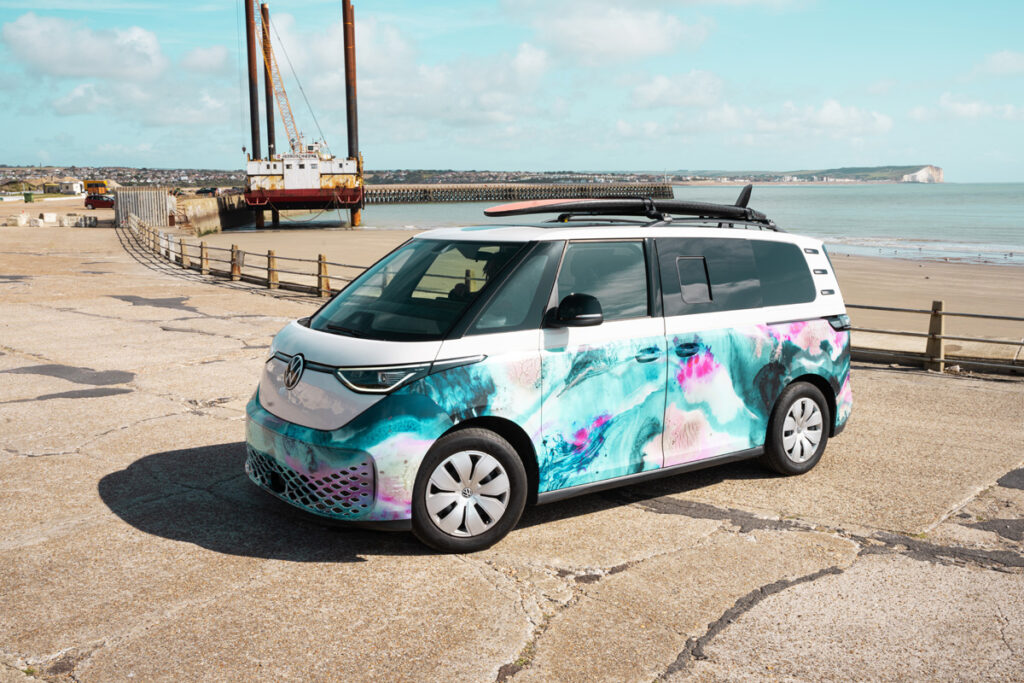
The Space Heating Challenge: When Even Big Batteries Aren’t Enough
If cooking is difficult, space heating is the final boss level of electric campervan design.
Here’s the uncomfortable truth: To heat a space adequately, typical campervan air heaters can draw 2000W-3000W or more continuously, and they need to run for hours, not minutes like a hob. Water heaters for showers add even more demand.
Could you theoretically power a 2000W electric heater from your lithium battery and inverter setup? Yes, briefly. But the power consumption would be so extreme that you’d drain even a massive 600Ah battery bank in just a few hours. And then what? You’re cold, your battery is dead, and your solar panels certainly can’t recharge that much capacity overnight or during short winter days.
The physics is brutal: A full electric heating system that works off-grid would require a battery bank so large and an inverter so powerful that it would fill entire cupboards, add hundreds of kilograms to your vehicle (goodbye payload capacity), and cost more than most people’s entire conversion budget.
It’s just not practical. So what do people actually do?
Real-World Heating Solutions for Electric Campervans
Option 1: Gas Heating (The Pragmatic Compromise)
Many people who want electric cooking but need reliable off-grid heating choose a gas-powered air and water heater. Modern systems like Webasto or Truma are efficient, reliable, and proven over decades of use in campervans and boats.
Yes, you’ll have a small gas bottle on board, but it’s isolated to heating only – your cooking remains fully electric. For many owners, this represents the sweet spot: electric independence for daily tasks with gas providing the heavy-duty heating when needed.
Best for: Fiat e-Scudo conversions and other vehicles where we can safely install gas systems through the chassis.
Not suitable for: VW ID Buzz – the chassis design doesn’t allow us to drill through for gas fittings, making a gas installation impossible. More on this in a moment.
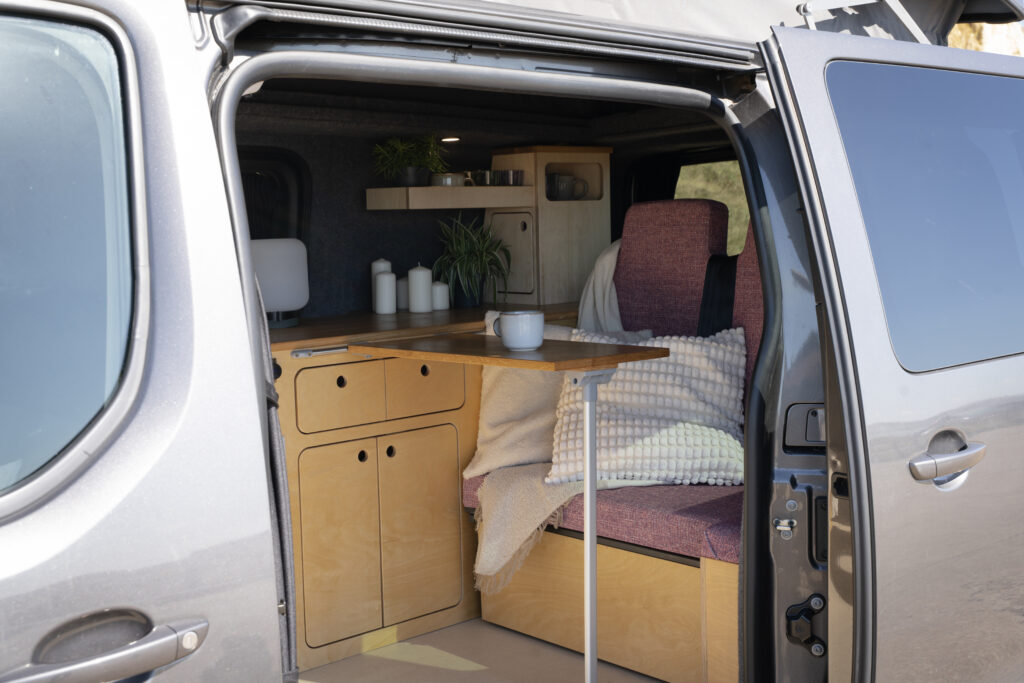
Option 2: Hook-Up Only Heating
Some owners accept that heating is something they’ll only use when parked at a campsite with electrical hook-up. In this scenario, you can use a simple electric heater that plugs into your 230V outlets when you’re connected to mains power.
Pros: Cheap, simple, effective when you have shore power.
Cons: No heating while wild camping or off-grid. You’re tethered to campsites during cold weather.
Best for: Fair-weather campers who primarily use campsites, or those who avoid winter camping altogether.
Option 3: Vehicle Heating + Insulation + Clever Tactics
Here’s where heating your electric campervan gets creative! Many electric campervan owners, especially VW ID Buzz owners who can’t have gas systems, use a combination approach:
Use Your Vehicle’s Heating System: Your EV has a powerful heating system designed to heat the cabin. While it’s not designed for continuous use while parked, a quick 10-15 minute blast can warm things up nicely. Just be mindful of your traction battery level.
Quality Insulation is Your Friend: We install Thermafleece insulation and proper lining in all our conversions. This natural, sustainable insulation helps your van retain heat far longer than cheap foam alternatives. A well-insulated van stays warm for hours after heating.
12V Electric Blankets: Don’t laugh – they’re brilliant! Drawing minimal power from your 12V system (typically 3-5 amps), electric blankets keep you cozy in bed without draining your battery. It’s often warmer to heat the person than the space.
Heated Seat Cushions: Similar principle to blankets but for daytime comfort. These portable 12V heated cushions draw modest power and make a surprising difference to your comfort level.
Layer Your Clothing: It’s low-tech, but effective. Good base layers, fleece, and a quality sleeping bag go a long way.
Strategic Planning: Many ID Buzz owners simply avoid camping in extreme cold, or plan their trips to include regular hook-up sites during winter. There’s no shame in working with your system’s limitations rather than against them.
Option 4: Strategic Planning and Seasonal Use
Many electric campervan owners simply plan their trips strategically, avoiding extreme cold weather camping or ensuring they have access to hook-up during winter months. There’s wisdom in working with your system’s capabilities rather than fighting against them.
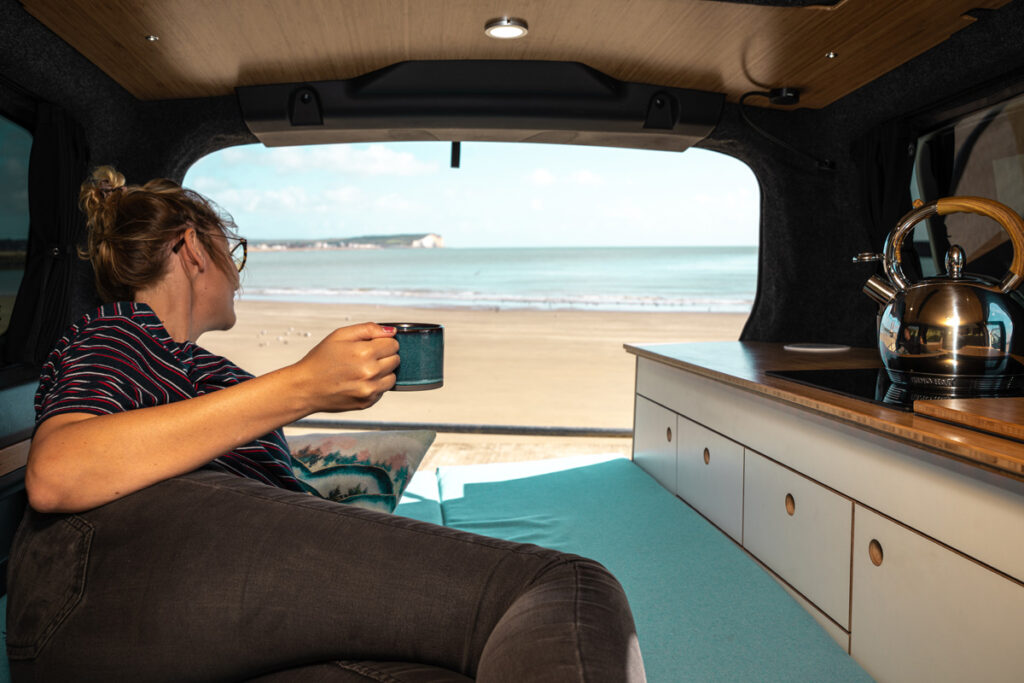
The VW ID Buzz: A Special Case Study
The ID Buzz deserves its own section because it represents both the best and worst of electric campervan heating challenges.
The Good: It’s a brilliant electric vehicle that drives beautifully with that classic VW charm. It’s compact but well-designed, and owners absolutely love them.
The Challenge: The ID Buzz chassis design makes it impossible for us to install a gas system. There’s simply no way to safely drill through for gas fittings while maintaining the vehicle’s structural integrity and safety certifications.
So what do ID Buzz camper owners do? They embrace the limitations:
- Vehicle heating for warmth when needed
- 12V electric blankets for sleeping
- Hook-up heating when at campsites
- Excellent insulation to retain whatever heat they generate
- Strategic trip planning around weather and campsite availability
And you know what? They’re genuinely content with this approach. The ID Buzz community has accepted that off-grid winter camping in freezing conditions isn’t this vehicle’s strong suit – and they’ve adjusted their camping style accordingly.
It’s a reminder that sometimes the best solution is acceptance and adaptation rather than fighting physics.

Making Your Electric Campervan Dream a Reality
So where does this leave you?
If you want a fully electric campervan with induction cooking that works off-grid, it’s absolutely doable – but you need to invest in a proper electrical system:
✅ Lithium battery bank (300Ah minimum, 400-600Ah recommended)
✅ 2000W pure sine wave inverter
✅ Solar charging system (around 140W for small vans with flexible panels)
✅ Quality battery-to-battery charger
✅ Professional installation ensuring all components work together safely
This will cost more than a gas hob system. There’s no getting around it. The components are more expensive, the installation is more complex, and you need more supporting infrastructure.
But for the right person – someone who values energy independence, wants to avoid gas, has the budget for a premium electrical system, and uses their van regularly – it’s an investment that pays dividends in peace of mind and capability.
What About Heating?
For space and water heating, your realistic options are:
- Gas heating system (most practical for year-round off-grid use)
- Hook-up only heating (fine for campsite users)
- Vehicle heating + insulation + clever tactics (works for many, especially ID Buzz owners)
- Strategic seasonal planning (avoiding extreme cold or planning around hook-up availability)
The dream of a fully electric heating system that works off-grid for extended periods? It’s technically possible but financially and practically impractical for most campervan builds. The battery bank and inverter you’d need would be enormous, prohibitively expensive, and use up all your available space and payload capacity.
Talk to Us About Your Electric Campervan System
Every campervan conversion is unique, and what works for one owner might not work for another. Your usage patterns, budget, vehicle type, and comfort with different solutions all play into designing the right system.
We specialize in creating bespoke electrical systems for electric campervans – from basic setups with hook-up heating to fully-equipped off-grid systems with induction cooking and comprehensive solar charging.
Whether you’re converting a Fiat e-Scudo, a VW ID Buzz, or any other electric vehicle, we can help you understand your options and design a system that matches your camping style and budget.
The most important thing? Be honest with yourself about how you’ll actually use your campervan. If you’re a fair-weather weekend warrior who primarily uses campsites, you don’t need the most comprehensive electrical system. But if you’re planning extended off-grid adventures with daily cooking needs, cutting corners will leave you frustrated.
We’d rather have the honest conversation up front about what’s realistic than have you disappointed with your system six months down the line.
Ready to Design Your Electric Campervan System?
Browse our full campervan conversion options or our instant campervan unit, the Sunbox Pod to get an idea of what you might be looking for. Once you’ve done that, please get in touch to discuss your specific requirements. We’ll walk you through the options, explain the costs and trade-offs, and help you make an informed decision about what’s right for your electric campervan adventure.
Because going electric is brilliant – but going electric intelligently is even better.
